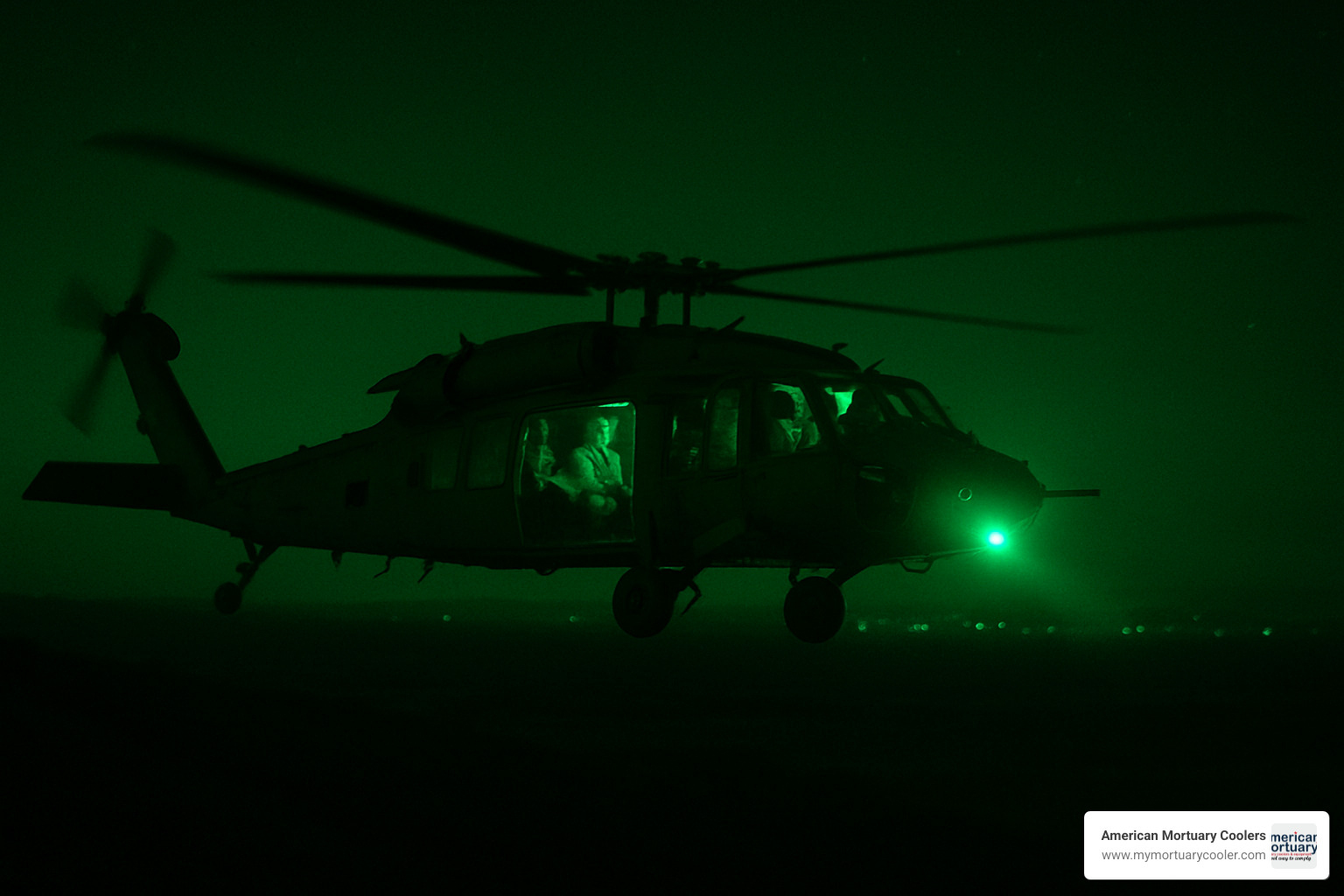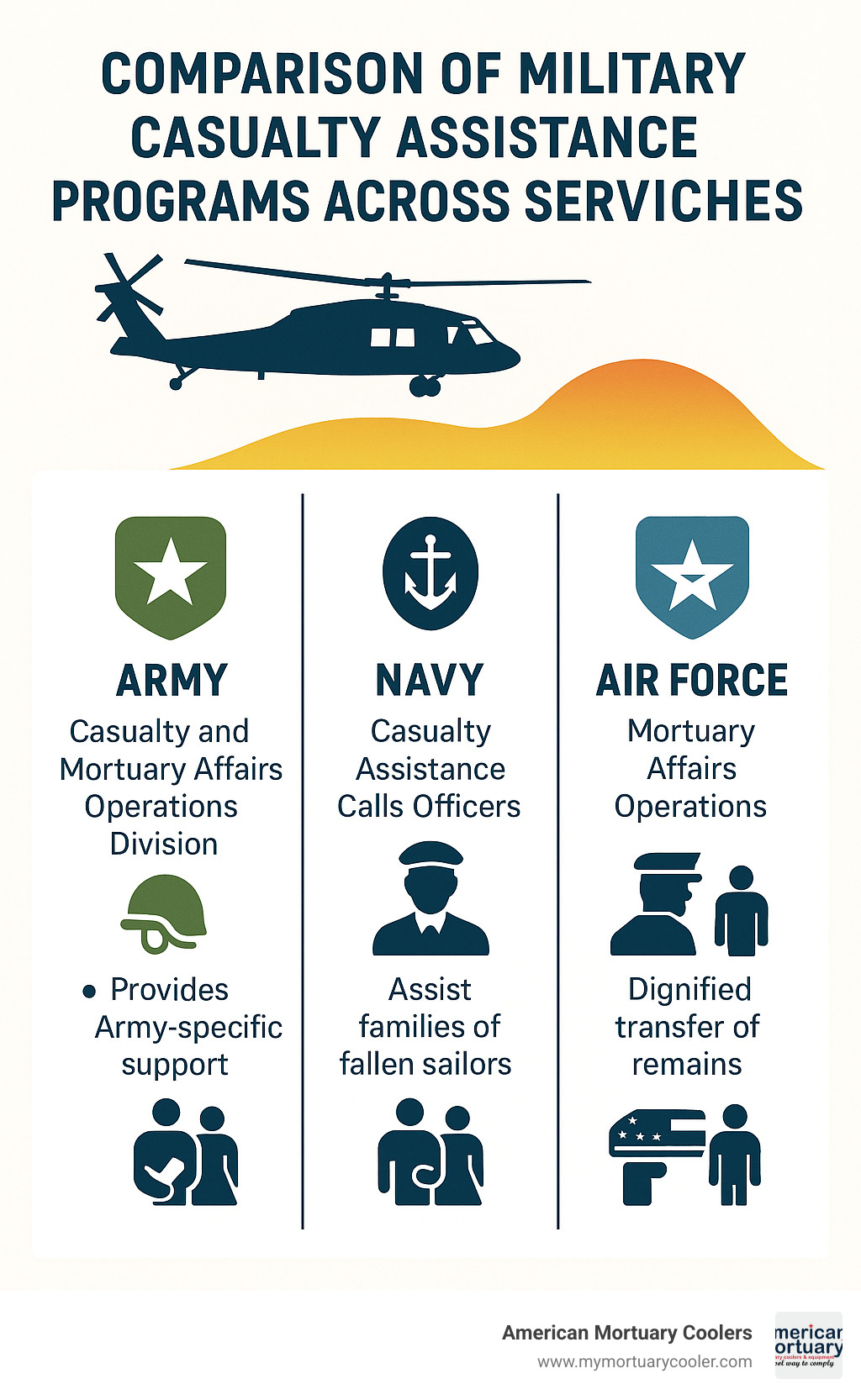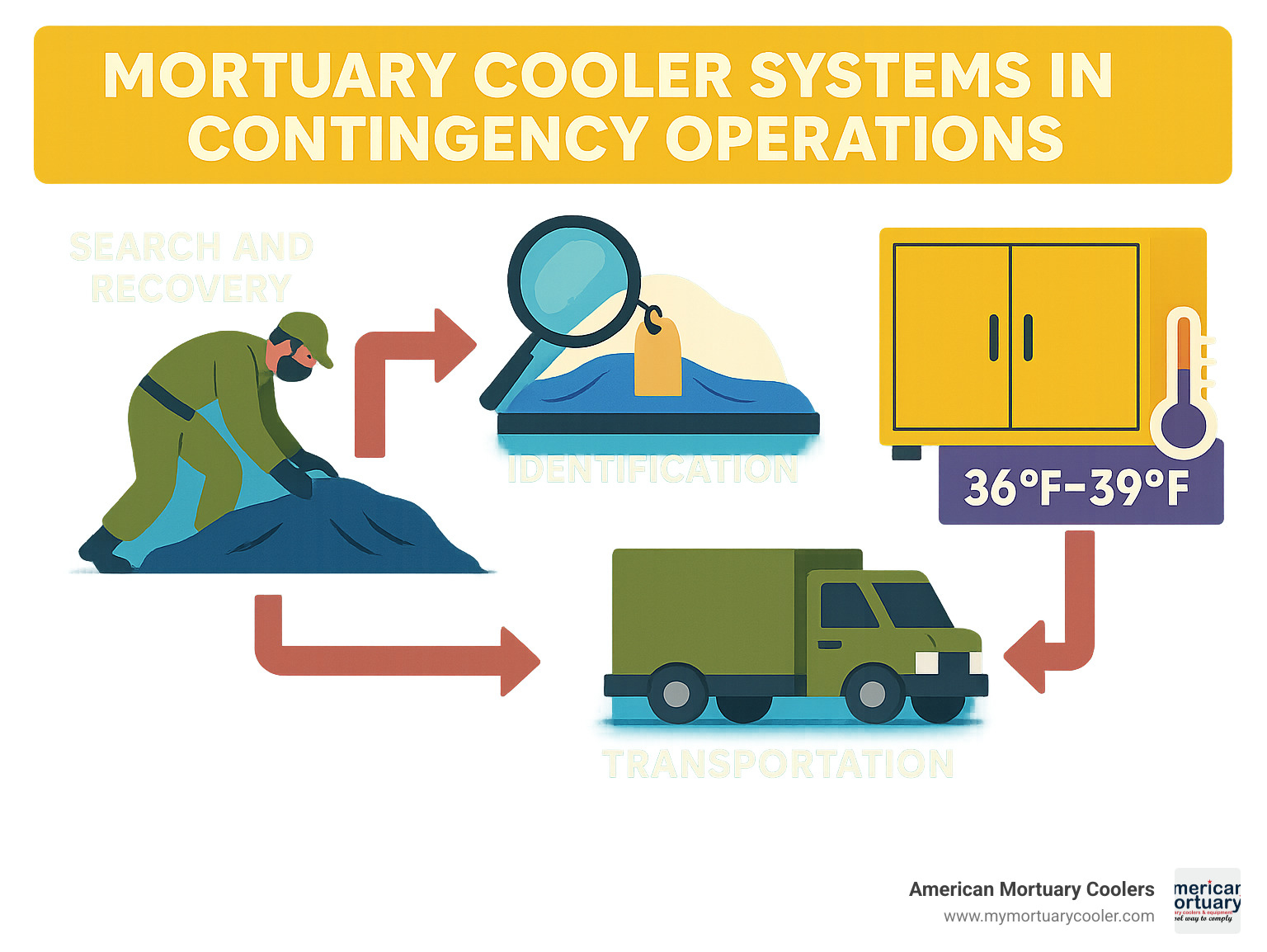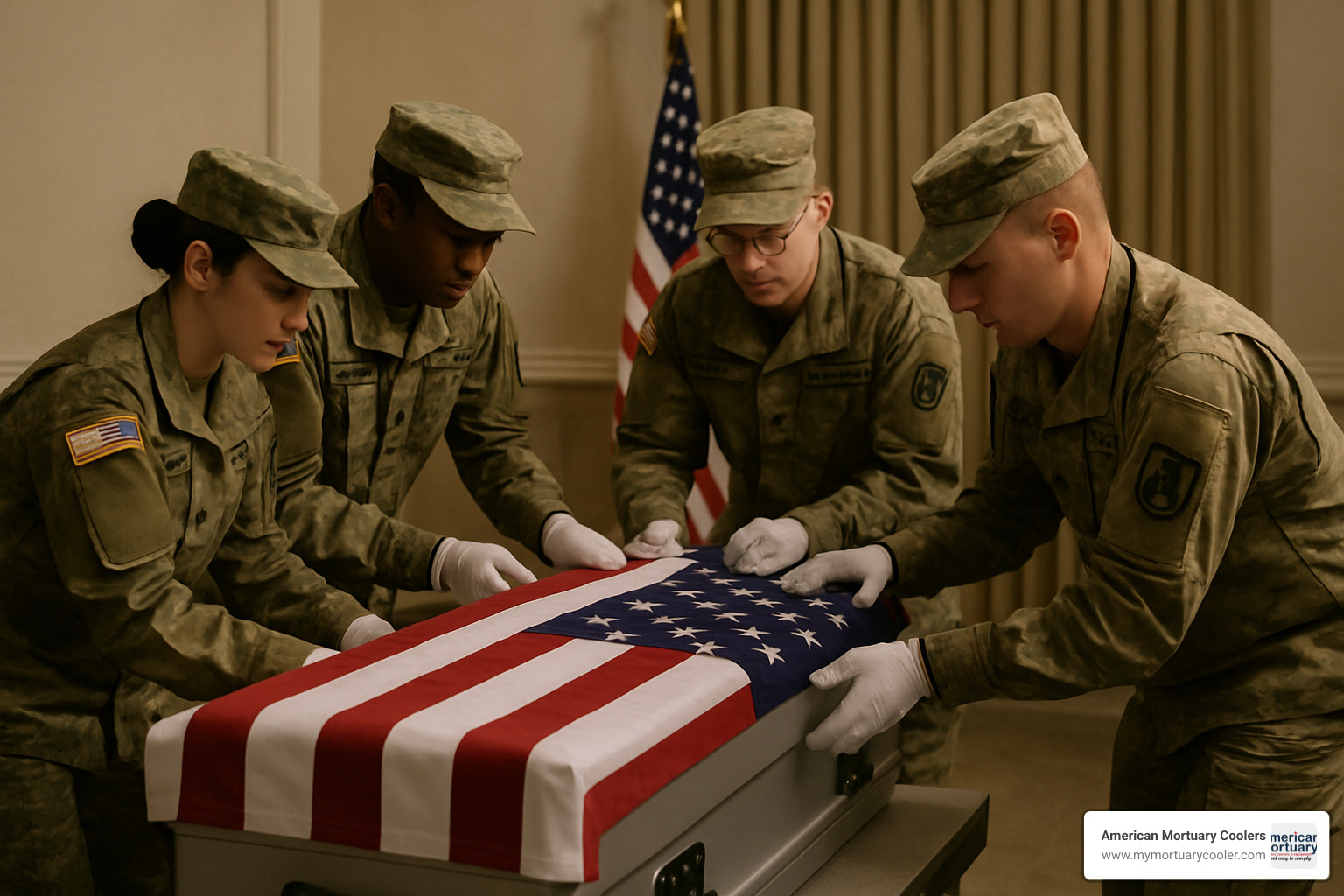
An Essential Guide to Contingency Operations-Related Death Benefits
Understanding Contingency Operations-Related Deaths
For contingency operations-related deaths, the Department of Defense has established comprehensive procedures to ensure dignity, honor, and support for fallen service members and their families. Here's what you need to know:
- Definition: Deaths occurring during named military operations outside the United States, including combat and non-combat incidents
- Initial Reporting: Must be reported within 1 hour to command centers
- Notification Process: Next of kin are notified by trained Casualty Assistance Calls Officers (CACOs)
- Benefits: Include $100,000 death gratuity, SGLI insurance, burial allowances, and survivor benefits
- Dignified Transfer: Formal ceremony at Dover Air Force Base for remains returning to U.S.
- Mortuary Affairs: Professional handling with appropriate refrigeration and transportation
When a service member dies during contingency operations, the military activates a carefully orchestrated process that balances operational needs with compassionate family support. This system ensures proper care from the point of casualty through final resting place.
As funeral directors know, maintaining dignity throughout this process requires proper equipment and protocols. For contingency operations-related deaths, temperature-controlled environments are essential during transport and preparation.
I'm Mortuary Cooler, a national supplier of mortuary refrigeration systems with extensive experience providing equipment used for contingency operations-related deaths through government contracts and private funeral home partnerships.

Key terms for for contingency operations-related deaths:
What Are Contingency Operations?
When you hear the term "contingency operations," we're talking about military missions that take place beyond U.S. borders in response to wars, national emergencies, or other special circumstances. The Department of Defense officially defines these under Title 10 U.S.C. as situations where our military personnel are—or might become—involved in military actions against enemies of the United States.
These aren't your everyday military activities. Contingency operations range from major combat deployments to humanitarian missions helping communities recover from disasters. What makes them different is that they typically involve sending troops to foreign territories, use special funding channels, and require specific reporting procedures.
For contingency operations-related deaths, the Department of Defense follows special protocols that differ from those used when service members pass away during regular stateside duties. These protocols ensure proper care, family notification, and support regardless of where the tragedy occurs.
"Contingency operations funding is specifically designated to cover incremental costs directly attributable to the operation," as the DoD Financial Management Regulation explains. This includes expenses related to mortuary affairs and providing assistance to families when deaths occur during these missions.
These operations include a wide range of activities:
- Peacekeeping missions to maintain stability in troubled regions
- Disaster relief efforts following earthquakes, floods, or other catastrophes
- Evacuating civilians from dangerous situations
- Counterterrorism activities to prevent attacks
- Humanitarian missions sanctioned by the United Nations
Scope and Categories
Deaths during these operations fall into several distinct categories, each requiring specific handling:
- Combat Deaths: These result directly from hostile action, such as firefights or bombings
- Non-Combat Deaths: Including accidents, illness, and self-inflicted wounds that occur in the operational theater
- Hostile Action: Specifically deaths from enemy fire, improvised explosive devices, or other adversary actions
- Training Accidents: Fatalities that occur during preparation or exercises while deployed
- Contractor Deaths: Non-military personnel supporting military operations
- Civilian Deaths: Government employees working in the operational area
The statistics tell an important story here. Non-combat deaths make up about 10% of total U.S. military fatalities in recent conflicts. Looking at Operations Iraqi Freedom and Enduring Freedom, of the 6,840 service members who lost their lives, 689 were classified as non-combat fatalities.
Common Causes of Death
For contingency operations-related deaths, the causes vary widely depending on the mission type. Based on historical data, we commonly see:
Improvised Explosive Devices (IEDs) have been the leading cause of hostile deaths in recent conflicts, claiming 2,550 lives during operations in Iraq and Afghanistan. Aircraft mishaps and vehicle accidents accounted for 362 deaths during Operations Iraqi Freedom and Enduring Freedom.

Other common causes include illness and natural causes like heart attacks and strokes, self-inflicted wounds which require especially compassionate handling, and mass-fatality events such as helicopter crashes that claim multiple lives at once.
Recent incidents highlight that risks persist even in training environments. In November 2023, five Army Special Operations aviation soldiers lost their lives during routine flight training when their helicopter contacted water in the Mediterranean Sea.
At American Mortuary Coolers, we understand the sacred trust involved in caring for those who've made the ultimate sacrifice. Our mortuary refrigeration systems are designed to maintain optimal preservation temperatures (36°F–39°F), ensuring dignity and respect for the deceased while giving families the time they need to make funeral arrangements.
Key Policies and Authorities for Contingency Operations-Related Deaths
When it comes to honoring our fallen heroes, the Department of Defense doesn't leave anything to chance. They've created a careful framework of policies that guide how we handle deaths during contingency operations with the dignity and respect our service members deserve.
Think of these policies as the backbone of our nation's promise to care for those who've made the ultimate sacrifice. The three most important ones are:
- DoD Directive 1300.22 - This establishes the Mortuary Affairs Program and clearly assigns who's responsible for what
- DoD Instruction 1300.18 - Outlines exactly how personnel casualties should be handled and how families must be notified
- DoD Instruction 1300.29 - Makes it clear that there should never be delays in transporting remains and authorizes those solemn ramp ceremonies
Behind these policies are dedicated teams of professionals who put these words into action:
The Air Force Mortuary Affairs Operations (AFMAO) manages those dignified transfer ceremonies at Dover Air Force Base. If you've ever seen the news footage of flag-draped transfer cases being carried with such precision from aircraft, that's AFMAO's work.
For Army families, the Casualty and Mortuary Affairs Operations Division (CMAOD) oversees all the specific procedures when an Army soldier falls. Similarly, the Marine Corps has their Casualty Assistance Calls Officers (CACOs) who provide direct, personal support to families during their darkest hours.
To ensure consistency, the Central Joint Mortuary Affairs Board brings representatives from each service branch together. This ensures that whether your loved one served in the Navy, Army, Air Force, Marines, or Coast Guard, they receive the same level of care and honor for contingency operations-related deaths.

The DoD also runs the Gold Star Lapel Button Program, a small but meaningful way to recognize families who've lost someone during these operations. In 2020, they expanded this program to include stepsiblings – acknowledging that families come in all forms, and grief touches everyone connected to the fallen.
Line-of-Duty Determinations for contingency operations-related deaths
When a service member dies during contingency operations, one of the first official steps is determining if the death occurred "in the line of duty." This isn't just bureaucracy – it directly affects what benefits the family receives.
For Army personnel, this process follows Army Regulation 600-8-4, which requires a preliminary inquiry within 24 hours. Think of it as the military's way of saying, "We need to understand exactly what happened so we can take care of your family properly."
Sometimes, a more detailed investigation happens under Army Regulation 15-6. These investigations aren't about assigning blame – they're about learning and preventing future tragedies. They help identify if procedures need to change or if there are safety issues that need addressing.
The Armed Forces Medical Examiner System (AFMES) plays a crucial role here too. Their forensic pathologists determine the official cause of death, providing answers that families often desperately need.
Reporting Requirements for contingency operations-related deaths
When it comes to contingency operations-related deaths, time is of the essence in reporting. The process starts with an initial voice report within just one hour to the Military Operations Center. Within 60 minutes of a tragedy, the wheels are already in motion to properly honor the fallen and support their family.
Next comes the Personnel Casualty Report through the DCIPS-Forward system, followed by supplemental reports as more information becomes available. For particularly serious incidents, an OPREP-3 Serious Incident Report is filed.
All this information flows into the Defense Casualty Information Processing System (DCIPS), which serves as the central hub for ensuring everyone involved has accurate information.
The timeline is strict and compassionate:
- Initial notification happens within 1 hour
- The Casualty Assistance Center is notified within 12 hours
- Family members receive a phone call within 72 hours
- Investigation updates come every 30 days
At American Mortuary Coolers, we understand our role in this solemn process. While military and government officials handle the notifications and paperwork, our mortuary cooling systems ensure that the fallen are preserved with dignity during these critical administrative processes.
From Battlefield to Burial: Notification, Dignified Transfer, and Mortuary Affairs
When a service member makes the ultimate sacrifice during contingency operations, a compassionate yet precise process begins—one that honors the fallen while supporting those left behind. This journey from battlefield to burial reflects our nation's commitment to treating our heroes with the dignity they deserve.
The Mortuary Affairs Program, established under DoD Directive 1300.22, serves as the backbone of this process. This program ensures that every fallen service member is treated with profound respect from the moment of death through their final journey home.
Dover Air Force Base in Delaware stands as hallowed ground in this process. Here, the Air Force Mortuary Affairs Operations (AFMAO) team works with quiet dedication, managing the dignified transfer of remains for all fallen service members arriving from overseas.

The dignified transfer isn't just a procedure—it's a solemn ceremony marking a hero's return to American soil. Each element carries deep meaning: the carry team moving with measured steps, the crisp military salute, the presence of senior officers standing in silent respect. For many families who choose to attend, this ceremony represents the first step in their journey of grief and healing.
Families never walk this path alone. The Campus for Families of the Fallen at Dover provides a sanctuary during this unimaginable time—a place where privacy is protected and comfort is prioritized. The complex includes a Family Center, Fisher House accommodations, and a peaceful Meditation Pavilion.
Each military branch assigns specially trained personnel who serve as guides through this difficult time. Whether they're called Casualty Notification Officers (CNOs), Casualty Assistance Officers (CAOs), or Casualty Assistance Calls Officers (CACOs), these dedicated service members become a lifeline for families—explaining benefits, answering questions, and providing steady support through funeral planning and beyond.
Chaplains and resiliency teams work alongside these officers, offering spiritual comfort and emotional support to grieving families and mortuary affairs staff who perform this challenging yet sacred work.
For contingency operations-related deaths, maintaining the dignity of the fallen requires proper preservation. At American Mortuary Coolers, we understand this responsibility deeply. Our mortuary refrigeration systems maintain the optimal 36°F–39°F temperature range that ensures remains are preserved with respect while allowing families sufficient time for meaningful goodbyes.
Search, Recovery, and Mass-Fatality Management
The journey home often begins in difficult circumstances—on battlefields, in remote locations, or following catastrophic incidents. Specialized teams conduct meticulous search and recovery operations, working with reverence to ensure every fallen service member returns home.
When death occurs, particularly in active-duty situations, the scene must be preserved until Criminal Investigation Division (CID) personnel and safety representatives complete their work, as Army Regulation 385-10 requires. This careful documentation honors the fallen by ensuring their story is accurately recorded.
The Armed Forces Medical Examiner System (AFMES) brings scientific expertise to this solemn process. Their professionals work with precision to identify remains, determine cause of death, and document injuries—all while treating the fallen with unwavering respect.
When tragedy strikes on a larger scale, with five or more casualties, additional protocols activate immediately. Extra mortuary affairs personnel deploy, temporary morgue facilities may be established, and special Mass Casualty Codes in DCIPS-Forward help expedite the process.
The equipment used in these operations must be both practical and respectful. Body lifts allow for safe, dignified handling while protecting staff from injury. Portable morgue facilities bring essential capabilities to remote locations, including examination areas, documentation stations, and critically important refrigerated storage.

At American Mortuary Coolers, we've designed our equipment with these challenging environments in mind. Our portable body boxes accommodate between one and six fallen heroes depending on size, and can operate from standard outlets even in field conditions. For larger operations, our walk-in coolers provide efficient, respectful storage with adjustable shelving systems.
Funeral Honors & Half-Staff Protocols
The final farewell to those who die during contingency operations includes Military Funeral Honors as prescribed by DoD Instruction 1300.15. These ceremonies reflect our nation's gratitude and respect through time-honored traditions.
For contingency operations-related deaths, these honors include at minimum a two-member uniformed detail who stand in solemn tribute. The haunting notes of Taps echo across the ceremony ground. The American flag, draped over the casket throughout the service, is carefully folded with precision into the symbolic triangle and presented to the family with words of gratitude for their loved one's service and sacrifice.
Throughout this process, the Person Authorized to Direct Disposition (PADD)—designated on the service member's DD Form 93—makes decisions regarding final arrangements. Recognizing the financial burden travel can place on grieving families, the military may issue Invitational Travel Orders (ITOs) to cover expenses for those attending services.
Our nation's mourning extends beyond the cemetery. DoD Instruction 1005.06 governs when and how flags are displayed at half-staff following a service member's death. For those lost in contingency operations, this visible symbol of national grief may appear at military installations and certain federal buildings.
Survivor Benefits, Entitlements, and Cost Management
When a service member dies during contingency operations, families face not only emotional devastation but also sudden financial challenges. Thankfully, the government provides substantial support to help ease these burdens during an incredibly difficult time.
For contingency operations-related deaths, surviving families receive immediate financial assistance through the Death Gratuity program - a tax-free $100,000 payment designed to help with urgent expenses. This payment typically arrives within 72 hours, providing crucial support when families need it most.
"The death gratuity is meant to help the survivors in the immediate aftermath," explains a DoD spokesperson. "It bridges the gap until other longer-term benefits begin."
Beyond this initial payment, families are eligible for Servicemembers' Group Life Insurance (SGLI) benefits of up to $400,000. For civilian employees who perish during contingency operations, the Federal Employees' Compensation Act provides a similar death gratuity of up to $100,000.
Ongoing financial support comes through the Survivor Benefit Plan (SBP), which provides monthly payments based on the service member's rank and years of service. The Department of Veterans Affairs also offers Dependency & Indemnity Compensation (DIC), providing tax-free monthly payments to surviving spouses and dependent children.
Educational opportunities for survivors include benefits through the War Widows and Orphans Educational Assistance Act, helping spouses and children pursue higher education despite their loss. Additionally, DoD Instruction 1344.08 outlines burial and interment allowances that cover most funeral expenses.
Families also receive continued medical and dental benefits for one year following the death, military-paid relocation if needed, and housing allowance continuation to provide stability during transition.
Two key documents determine benefit eligibility: the DD Form 93 (Record of Emergency Data) and SGLV 8286 (Servicemembers' Group Life Insurance Election and Certificate). These forms highlight the importance of keeping beneficiary information current and accurate.
Estimating & Reporting Costs
Behind the scenes, the financial management of for contingency operations-related deaths involves careful tracking and reporting. The Department of Defense distinguishes between costs that would have occurred anyway (baseline costs) and those directly resulting from the contingency operation (incremental costs).
Mortuary affairs expenses typically fall under incremental costs, making them eligible for special contingency operations funding. This ensures proper care for the fallen without straining regular military budgets.
Financial teams must submit monthly contingency cost reports (SF 1080) to the Defense Finance and Accounting Service within 30 days of month-end. These reports require thorough documentation and variance analysis to explain significant changes in monthly expenses.
The Contingency Operations Support Tool (COST) helps financial managers develop accurate pre-deployment estimates and budget projections. For international operations, especially UN peacekeeping missions, special reimbursement rules apply, with costs billed under section 607 of the Foreign Assistance Act.
At American Mortuary Coolers, we understand the importance of cost efficiency in government contracts. Our mortuary refrigeration systems feature high-quality insulation that reduces long-term energy consumption, despite higher initial investment.
Long-Term Family Support
The military's commitment to families of fallen service members extends far beyond the funeral. For contingency operations-related deaths, support continues through programs like the Army's Survivor Outreach Services (SOS), which provides long-term assistance to families navigating life after loss.
Gold Star programs offer recognition and ongoing connection to the military community, helping families maintain meaningful relationships with those who understand their sacrifice. These programs include remembrance events, support groups, and resource coordination.
Professional counseling services remain available to family members struggling with grief, helping them process their loss and develop healthy coping strategies. Annual remembrance services bring families together to honor their loved ones' memories and connect with others who share similar experiences.
These comprehensive support systems reflect our nation's commitment to caring for those who have sacrificed so much. At American Mortuary Coolers, we're proud to play a small role in this sacred mission by providing the equipment that helps ensure dignity for the fallen throughout their final journey home.
Frequently Asked Questions about Contingency Operations-Related Deaths
Who is notified first and how quickly?
When a service member dies during contingency operations, a carefully orchestrated notification process begins immediately. For contingency operations-related deaths, the military follows a compassionate but structured approach to ensure families hear the news properly.
Within one hour of the incident, the casualty is reported up the chain of command through official channels. The military then dispatches a Casualty Notification Officer (CNO) to personally inform the primary next of kin. This in-person notification is handled with the utmost care and respect.
"The hardest knock on any door is the one that brings news of a fallen service member," explains a veteran CNO. "We ensure families hear this difficult news from a person, not from social media or a news report."
The military strictly enforces a media blackout until official notification is complete. Only after the primary next of kin has been informed will secondary family members be notified.
What benefits start immediately after death?
Families facing the loss of a service member during contingency operations receive immediate financial support to help manage the difficult days ahead. For contingency operations-related deaths, several benefits activate right away:
The $100,000 death gratuity is processed immediately to help with urgent expenses. This tax-free payment typically reaches families within 72 hours. Any unpaid pay and allowances that were due to the service member are also promptly provided to the designated beneficiary.
Family members maintain their medical and dental coverage for a full year following the death, giving them time to transition to civilian healthcare options. Additionally, housing allowances continue during a transitional period, preventing families from facing immediate housing insecurity during their time of grief.
"The military understands that while nothing can replace your loved one, removing financial worries allows families to focus on healing," notes a Gold Star family advocate.
How are remains transported from overseas?
The journey home for a fallen service member is handled with dignity and precision. For contingency operations-related deaths, the transportation process honors the sacrifice while ensuring proper care of remains.

First, remains are carefully prepared and placed in a transfer case at the location where death occurred. Military personnel then arrange transport via dedicated military aircraft to Dover Air Force Base in Delaware, home of the nation's primary military mortuary.
At the Dover Port Mortuary, specially trained staff provide professional care, including preparation of the remains and placement in a casket selected by the family. Throughout this process, maintaining proper temperature control is essential for preservation and dignity.
A military escort is assigned to accompany the remains at all times. This escort stays with the fallen service member until arrival at the funeral home chosen by the Person Authorized to Direct Disposition (PADD). This continuous presence ensures the chain of custody remains unbroken and honors the fallen with a constant watch.
At American Mortuary Coolers, we understand the sacred nature of this journey. Our mortuary refrigeration systems are designed to maintain optimal temperatures during transportation and temporary storage, whether in field conditions or permanent facilities.
Conclusion
When it comes to for contingency operations-related deaths, our military's response reflects one of our nation's most solemn promises – that those who make the ultimate sacrifice will be treated with unwavering dignity and honor.
The journey we've described – from the battlefield to final resting place – isn't just a process. It's a sacred trust carried out by dedicated professionals who understand the weight of their responsibility. Each step, from initial notification to the dignified transfer at Dover, from mortuary preparation to the final military honors, represents our collective commitment to both the fallen and their families.
Throughout this difficult journey, proper care of remains is absolutely essential. Temperature control isn't just a technical requirement – it's a fundamental aspect of preserving dignity. This is where our team at American Mortuary Coolers takes particular pride in our contribution to this mission.
For contingency operations-related deaths, our custom-built mortuary refrigeration systems maintain that crucial 36°F–39°F temperature range that ensures remains are preserved with the utmost respect. We understand that these aren't just technical specifications – they're part of how we honor someone's loved one during their final journey home.
While larger nationwide manufacturers such as Mopec, Mortech Manufacturing, and Thermo Fisher Scientific often provide standardized equipment, American Mortuary Coolers differentiates itself by crafting durable, fully customized solutions and delivering them directly to clients across the contiguous 48 states.
We've built our company around supporting funeral professionals across the country with reliable, thoughtfully designed equipment. With manufacturing facilities in Johnson City TN, and service centers across the country including Atlanta GA and Chicago IL, we're positioned to support military installations and funeral homes throughout the contiguous 48 states.
When a family loses someone in service to our country, every detail matters. From the military's careful protocols to the equipment that supports those protocols, nothing should distract from providing the honor and respect deserved by those who gave everything for our nation.
If you'd like to learn more about how our mortuary cooler solutions support dignified handling of remains, please reach out to our team. We're here to help ensure that for contingency operations-related deaths, every aspect of care meets the highest standards – because anything less would be insufficient for those who gave so much.



